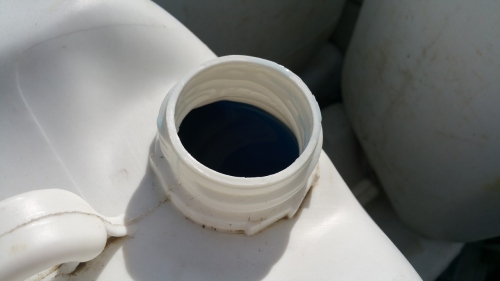The type of glycol chosen and used in the system can have enormous long-term repercussions for the efficiency and longevity of the system, so here is a guide to the types of glycol are available and why we only use a particular kind.
The glycol running through the heat collector transfers energy from the heat source, often the ground, to the heat pump. The heat pump raises the temperature and transfers the energy to the heating and hot water. A side-effect of the process is to cool the ground down. In a well-designed system, the ground collector is large enough so that the cooling of the ground is only by a sustainable amount. However it is normal for the glycol to be running at a temperature below 0oC. This is why the heat transfer fluid has to be an antifreeze that remains liquid at the working temperatures of the system.
There are many chemicals that have been used as antifreezes but only a few are in common use today. The key technical parameters are the heat capacity of the liquid (how effective it is at transferring energy), the density and the viscosity which together govern how much energy is required to pump the liquid around the system. The antifreeze must also be harmless to the materials that the system is made from, and it is essential to consider the hazards of handling the material during installation, the long-term risks in case the system leaks into the environment, and the durability of the fluid. For example, salt water (brine) freezes at temperatures below zero but would be a poor choice of antifreeze for a heat pump as it would lead to rusting of the system. Modern antifreezes are all organic chemicals either derived from vegetable feedstocks or from oil. Each antifreeze has its own advantages and disadvantages.
Ethylene glycol has a low-density, good heat carrying properties and low viscosity. Seen purely from a technical point of view it is the best antifreeze for heat transfer. However it is highly toxic to humans and animals, handling it on site requires care to protect the skin from contact because of the risk of dermatitis, and the lethal dose for ingestion is about 1 litre for an adult male. So any leak during installation or afterwards is potentially dangerous and may need to be reported to the Environment Agency. Ethylene glycols are widely used in coolant systems for cars and used to be used for aircraft de-icing. However nowadays aircraft de-icing normally uses propylene glycol because it is safer for the people doing the work and the run-off is not harmful to the environment.
We too only recommend installing propylene-glycols. Propylene glycol is closely related to ethylene glycol but it is denser and more viscous and so is slightly less good as a heat transfer fluid. However it has the enormous advantage of being non-toxic. In fact it is often used as a food additive! We use it at a concentration that gives frost protection to -10oC, enough to protect the system and still to perform efficiently. The propylene glycols used in heat pump systems have further additions of corrosion and scale protection additives and a colourant to make them easily identifiable. We will also treat the ground array, during the installation after they have been flushed out with clean water, with a cleaning agent (biocide) to make sure that micro-organisms have been killed.
A risk with all glycols is that they will become contaminated by micro-organisms and will start to degrade. A common effect of glycol degradation is to increase the viscosity and hence the pumping costs. Eventually the heat pump may stop working if the brine flow becomes too slow. If this situation is detected early, during a service visit, it is likely to be possible to treat the system with biocide to destroy the micro-organism and preserve the glycol for a few more years. A glycol system that is too far degraded will need to be drained, flushed, treated with biocide, and refilled with a fresh glycol.
If you would like any further information on the glycol we use, or indeed are considering changing the glycol in your system, then we are happy to advise on what could be done to improve the efficiency or environmental impact from your collector array.







